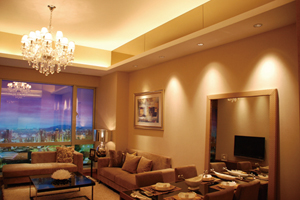Bright Future for LED Lighting in China
Home appliance giants seize new opportunity in Chinese LED market
2012/05/23 | By CENSBoth the rapid development of the LED industry and the Chinese government's active support have led traditional illumination businesses, brand home appliance sellers and electrical parts companies to enter this lighting market. Brand home appliance sellers that face fierce competition and slim profit margins see the emerging LED lighting industry as a bright opportunity.

TCL Lighting Co. was founded in 2000 and started its LED business in 2007. Home appliance sellers such as TCL have advantages in developing LED, according to its export manager Weihua Tsai. Tsai said that initially TCL produced color TVs that provided it with core technology for LED development that has contributed to the growth of the enterprise's main home appliance business.
In 2009 Skyworth Group Co. Ltd. established a wholly owned subsidiary, the Shenzhen Skyworth Lighting Electric Co., Ltd., to develop LED lighting products. A number of home appliance enterprises such as Midea, Konka and Changhong also jumped on the bandwagon and entered the LED market, taking full advantage of their resources and brand recognition to grow quickly. They have both acquired promising lighting companies and recruited top talent.

Brand Strength Helps
According to "The 2010 100 Most Valuable Global Brands List," these home appliance giants have become popular brands in China. Midea Group ranked sixth on the list, with an estimated value of RMB49.786 billion renminbi while TCL ranked seventh with RMB45.808 billion and Skyworth ranked 14th with RMB18.008 billion.
The Chinese LED industry started in the 1970s as an emerging industry, and now the focus is on developing commercial lighting. Although compared to home appliance giants, LED lighting companies lack sales experience in the household products market and the cost of these lights for home use remains high, the domestic appliance industry started early, developed fast, and businesses have learned how to open up market channels. Now they must focus on publicizing the energy-saving and environmental-friendly aspects of LED lights if they hope for increased profits from such lighting sales.

Business Advantage
Home appliance giants have a clear advantage over other lighting companies in terms of resources, channel costs and scale.
Skyworth Lighting's LED packing and constant current power designs and LED lighting products are the result of years of the Skyworth Group's technological research. International sales account for 60% of Skyworth's lighting revenue, thanks to the use of Skyworth Group's established channels.
Due to its scale, Midea has tremendous purchasing power in the markets for its products, including home, commercial, office and outdoor lighting, and LED and electrical sockets. It has a strong team of OEM&ODM suppliers and has further cut costs by integrating several of its parts manufacturers with its core lighting business.
TCL's core competitiveness consists of its strong sales network, logistical resources and capital utilization that allow it both to promote its products more while significantly reducing its sales costs.
Acquisition Strategy
Some large enterprises with famous brands, stable marketing channels and abundant funds have taken advantage of the explosive growth of the LED industry to acquire companies in the global LED market. According to market statistics, there have been around 20 large-scale acquisition deals in the global LED market, including China. For home appliance enterprises that want to enter the LED lighting market, one of the best ways to do so is by acquiring businesses.
At the end of 2009 Konka, the tycoon of color TV, invested in Refond Optoelectronic, forming a strong alliance where each partner excels in a different part of the supply chain. Konka has integrated vertically from LED epitaxial wafer to chip, from packing to module, and from outdoor LED display to LCD TV.
Similar to Konka, Skyworth and TCL have also integrated vertically upstream by establishing mass production bases and acquiring stakes in optoelectronic companies.
After penetrating the LED packing, illumination, backlight module and LED TV fields by cooperating with Epistar and Delta Electronics to produce epitaxial wafers, Skyworth started building a supply chain of raw materials and parts from modules to final finished products in 2009. It constructed the Skyworth Building in cooperation with the Shenzhen government and has achieved impressive economies of scale in the LED lighting market.
Total sales of TCL's subsidiary, CSOT Optoelectronics, have exceeded one million pieces of LEDs since the company started mass production in October 2011. Weihua said that TCL has cooperated with Harvatek, an affiliate of Taiwan's United Microelectronics Group, to establish the TCL-Harvatek packing factory that aims to become a leading LED packaging plant.
Key Factors in Development
Although home appliance giants have been active in LED development, they have yet to clearly position their products in the market. Weihua said that initially when manufacturers rushed to tap into the market LED products were homogeneous. After accumulating experience, manufacturers will subdivide product development and consumer groups.
Considering that annual sales income of most home appliance giants reach RMB30 billion, it is not to be expected that in the beginning their LED businesses provide them with solid returns. It takes time to grow in the LED lighting market, and educating consumers about LED lights is an important part of the process. Home appliance enterprises must understand that they won't make sudden large profits in the LED industry. Developing a long-term strategic plan is a key factor in future success.
Integration, mergers and acquisitions are expected in the LED industry both this year and in 2013. Enterprises that have already entered this market, such as professional LED lighting companies, general lighting companies and brand home appliance giants, will be affected by the trend.




